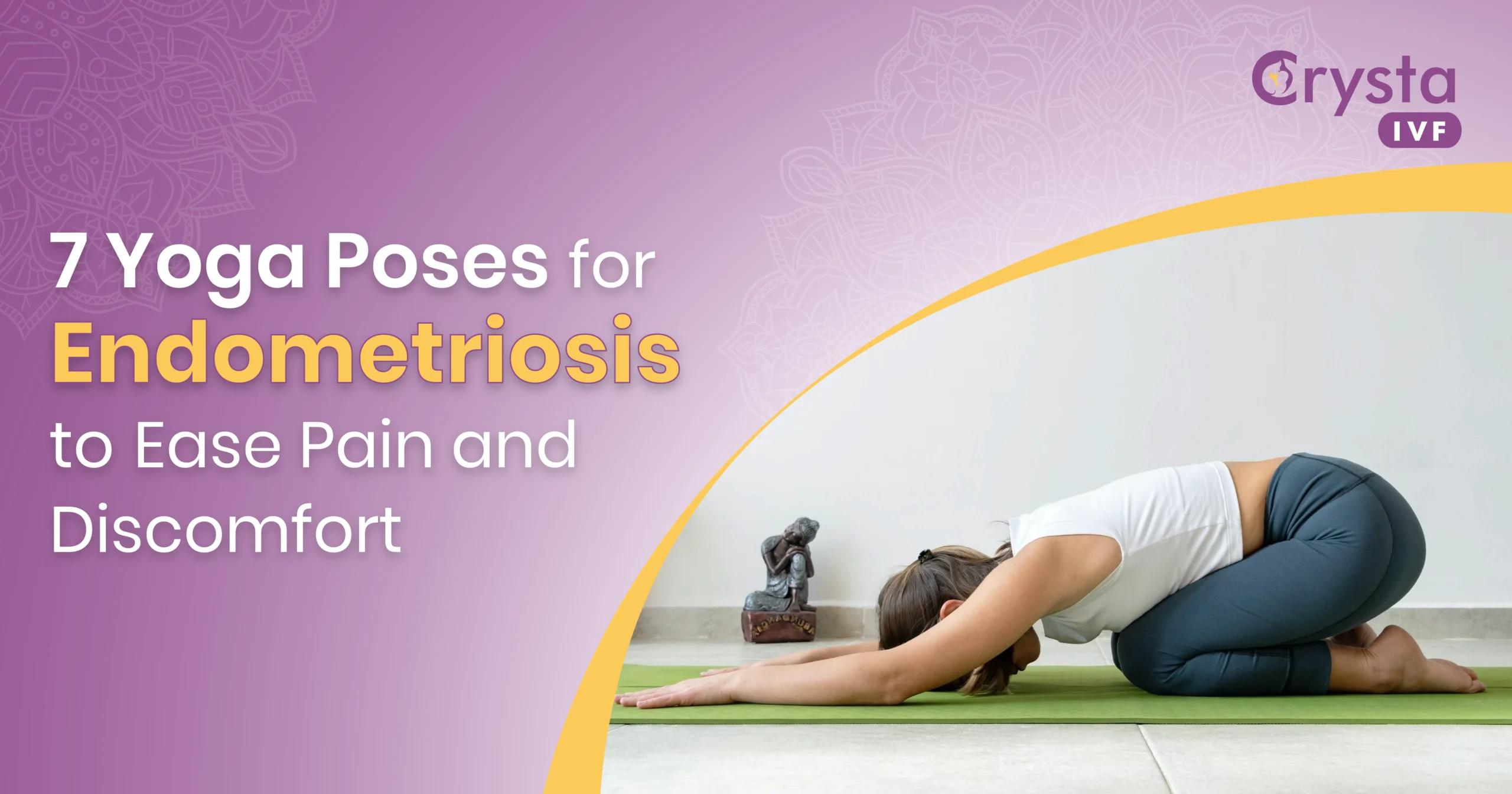According to WHO, Endometriosis is a gynecological illness that affects up to 190 million women globally. This problem can drastically lower the quality of life by causing painful periods, infertility, and other serious symptoms. But what if I say it is easy to manage endometriosis? There are certain medications, therapies, and yoga that can help you ease your pelvic pain caused by endometriosis.
Yoga is a fantastic choice for women searching for a low-risk strategy to manage their endometriosis. It can also help reduce symptoms. Yoga also helps to regulate the parasympathetic nerve system, which controls the body’s reactions to digestion. These reactions are essential for lowering endometriosis-related pain and tension, as they instruct the body to slow down and rest.
Here are 7 Yoga poses for endometriosis to lower your pelvic pain.
Understanding Endometriosis
The uterine lining is affected by the painful illness endometriosis. Endometrial tissue grows on the ovaries, fallopian tubes, pelvis lining, and uterus, causing pain and discomfort.
While endometriosis symptoms might vary from woman to woman, infertility, heavy periods, unpleasant menstrual cramps, and pain are common.
7 Best Yoga Poses for Endometriosis
Endometriosis patients experience constant pain and discomfort, but yoga helps break this pattern. It puts your body in a state of rest and healing. A study done in 2018 demonstrated that practicing yoga twice a week for 8 continuous weeks enhanced the mind-body connection and improved pain management. Here are the best 7 yoga poses for endometriosis.
1. Happy Baby Pose (Ananda Balasana)
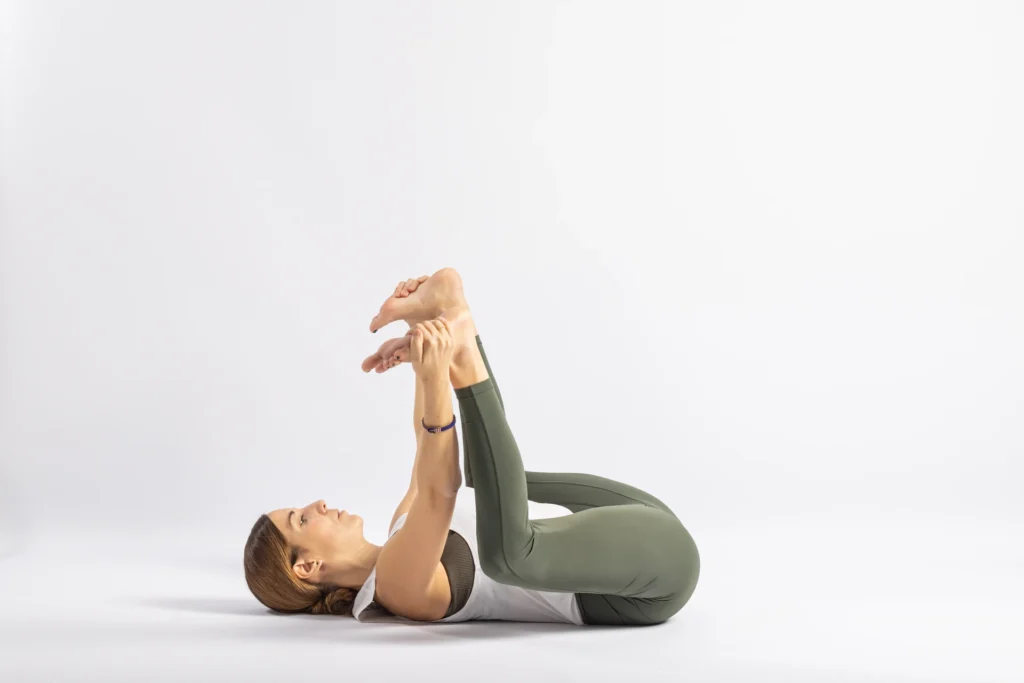
How it Helps:
It helps to release tension, stress, and cramps by stretching your hips and spine.
How to Perform:
- Lay down on the floor.
- Bring your hips down to rest on your heels.
- Put your knees in front of you or slightly apart from your hips.
- Fold your legs forward and hinge at your hips.
- Extend your arms out or next to your body.
- Practice this posture for a maximum of five minutes.
2. Child’s Pose (Balasana)
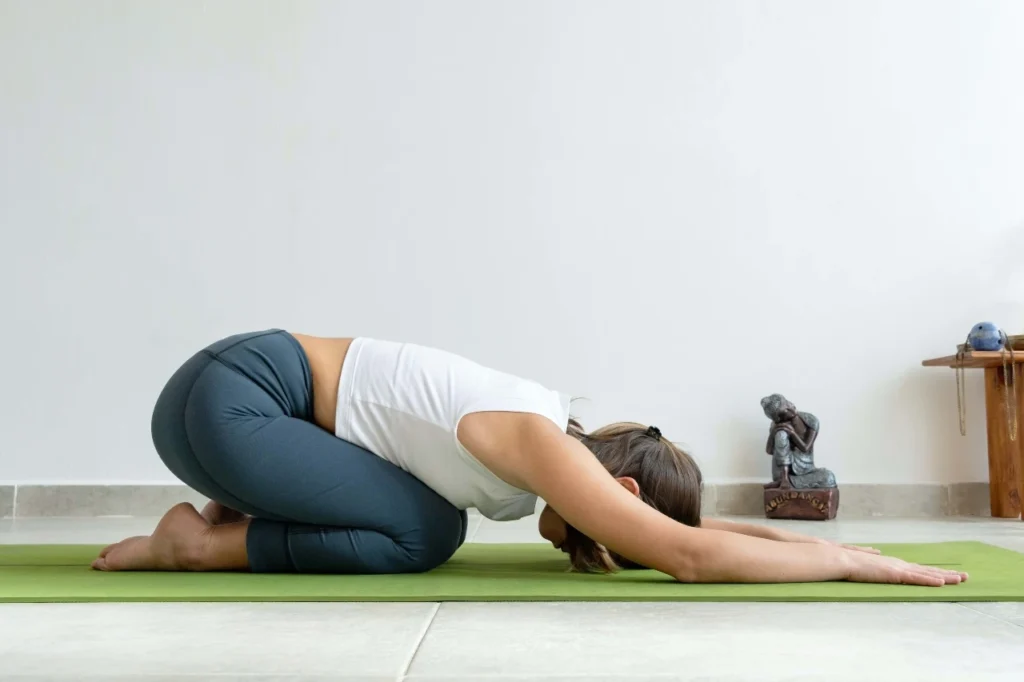
How it Helps:
It eases pain in the inner thighs, hamstrings, and lower back muscles and relaxes the pelvic muscles.
How to Perform:
- Take a back position.
- Your knees should be bent in the direction of your chest.
- Turn your feet in such a way that your soles face the ceiling.
- Put your hands on your feet’s outer edges.
- Press your feet down with your hands to provide resistance.
- Concentrate on relaxing your pelvic region and hips.
- Maintain this posture for one minute.
3. Restorative Goddess Pose (Supta Baddha Konasana)
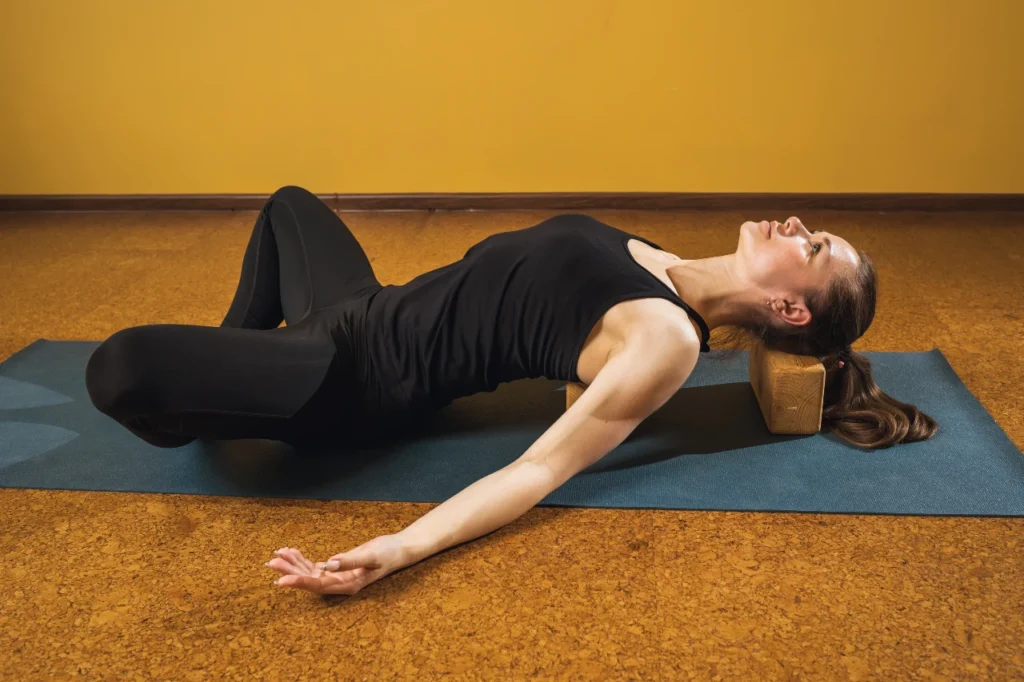
How it Helps:
It eases pelvic pain and abdominal stiffness. This asana also helps regulate the nervous system and opens up the inner thighs, hips, and chest wall.
How to Perform:
- Place a bolster beneath your thighs.
- Use yoga blocks and cushions to support this yoga position.
- Lie down with your head and spine supported by the cushions.
- Extend your arms to the sides with your hands facing up.
- Pay close attention to your deep breathing.
- Maintain this position for three to ten minutes.
4 – Spinal Twist (Supta Matsyendrasana)
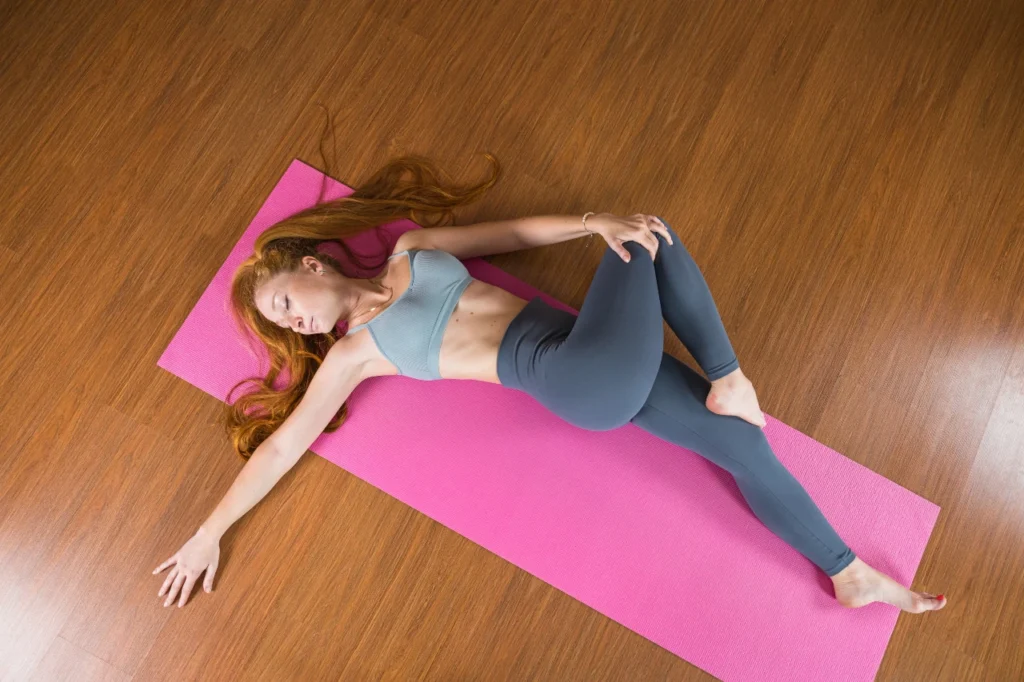
How it Helps:
This asana stretches your glutes, back, and chest, increasing spinal mobility.
How to Perform:
- Lay down straight on your bed, keeping your flat feet on the ground so that your knees are bent.
- Extend your arms straight to the sides with your palms facing the ground.
- Put a pillow or yoga block between your knees to support your sacrum and lower back.
- Breathe into your lower ribs and belly as you inhale.
- Bend your knees to the left as you release the breath.
- Repeat the task. Breathe deeply five times.
- Feel your ribs on either side and watch how they stretch and lengthen.
- Repeat this position on your right side 5 times.
5: Legs Up the Wall Pose (Viparita Karani)
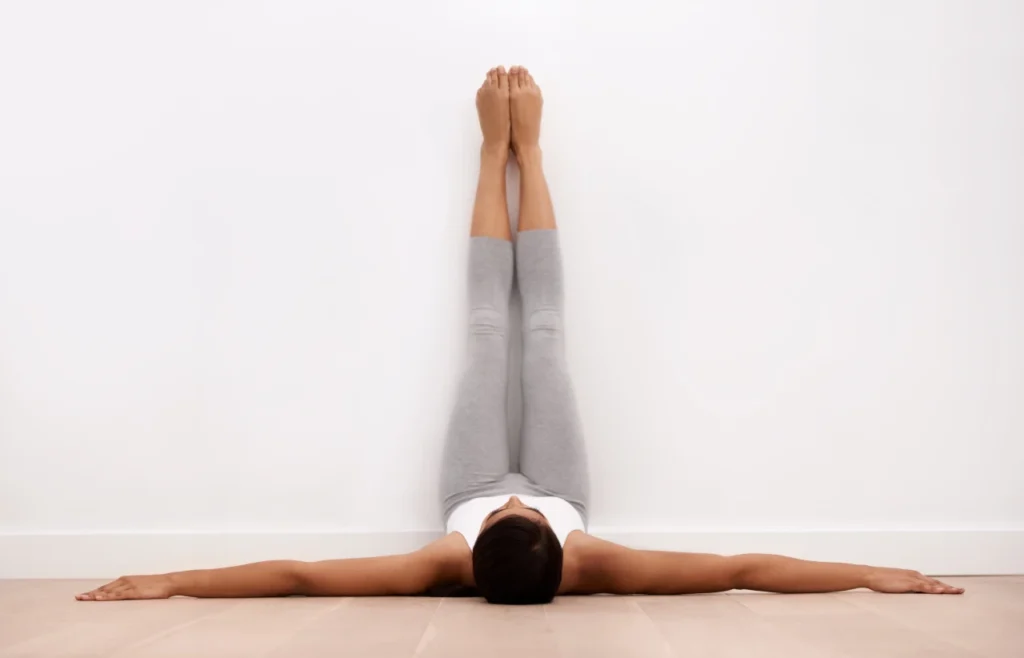
How it Helps:
It stretches your glutes, back, and chest while increasing spinal mobility.
How to Perform:
- Sit on the floor straight so your right side is against a wall.
- Lift your legs and place them against the wall while lying on your back.
- Place your against the wall or slightly away.
- Place your arms alongside your body.
- Practice this position for 15 continuous minutes.
6: Garland Pose (Malasana)
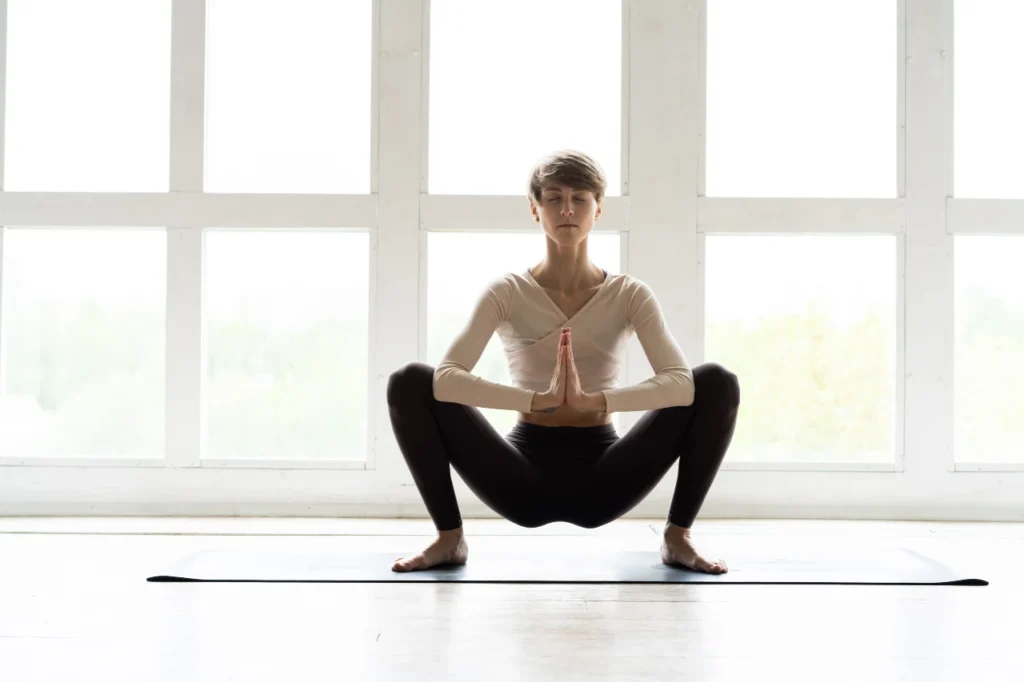
How it Helps:
This asana improves circulation and flexibility by extending the thighs, hips, and lower back. In addition to strengthening the pelvic floor muscles, it can help ease discomfort, cramps, and digestion issues.
How to Perform:
- Sit in such a way that your hips and feet are slightly apart.
- Join your hands such that your palms are together.
- Your toes must be out to the sides.
- Create a low squat by bending your knees and lowering your hips gradually.
- Stretch your spine and raise your pelvic floor.
- Put your elbows into your thighs to deepen the position.
- Take a minute or so to maintain this stance.
7. Reclined Hero Pose (Supta Virasana)
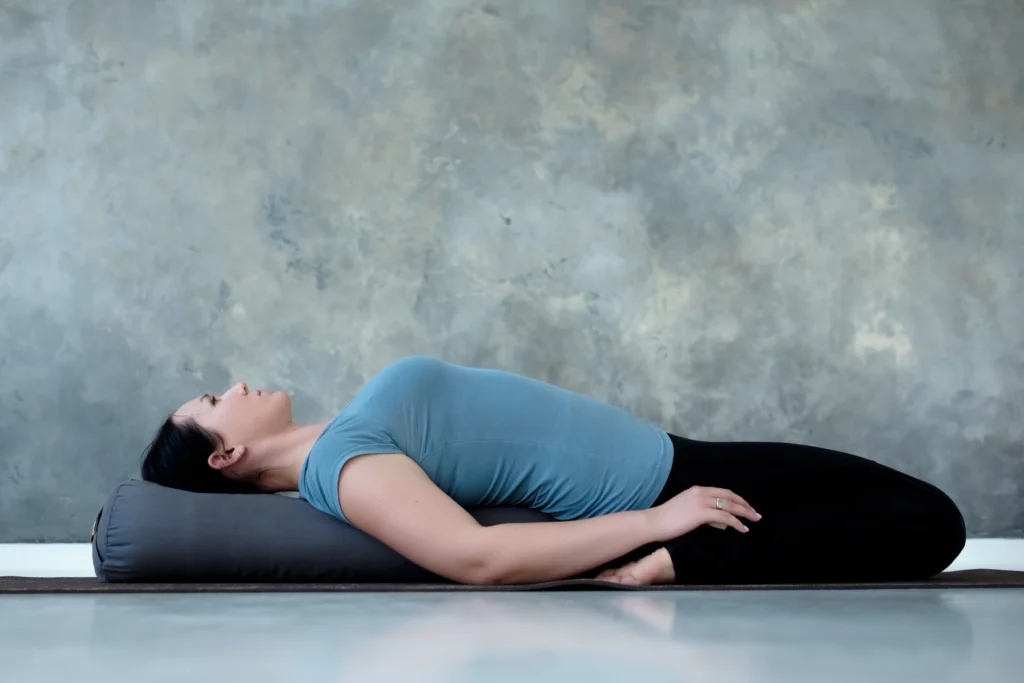
How it Helps:
It helps relieve abdominal and pelvic pain, discomfort, and bloating.
How to Perform:
- Lay down on your back.
- Spread your feet wider than your hips.
- Fold your legs in such a way that your feet touch your hips.
- Lean back, supporting yourself with your elbows and forearms.
- Align your arms at a little angle with your torso.
- Maintain this posture for at least 1 minute.
Can Yoga Cure Endometriosis?
Yoga is a physical activity that can prevent the pain and discomfort caused by Endometriosis. Along with certain medications and expert fertility doctor consultations, yoga can be more effective on your body.
- Yoga eases the pain in the pelvis brought on by endometriosis.
- Yoga reduces stress, which, in turn, helps balance endometriosis-related hormones.
- It also assists in addressing the psychological effects of endometriosis.
- It helps us reestablish our connection to parts of our bodies that we lose touch with when experiencing discomfort.
The Bottom Line
Do you want to stop experiencing endometriosis pain? Your new best friend may be yoga. It has many physical, mental, and emotional health advantages that can help manage and lessen the intensity of endometriosis symptoms.
Remember to treat your body gently with any asana you choose. Take your time and carefully practice each asana. Before beginning a new yoga program, especially if you are experiencing severe symptoms, consult with an experienced doctor. Contact Crysta IVF to get your endometriosis problem treated with expert advice, as endometriosis can lead to severe problems if it is not treated on time.

